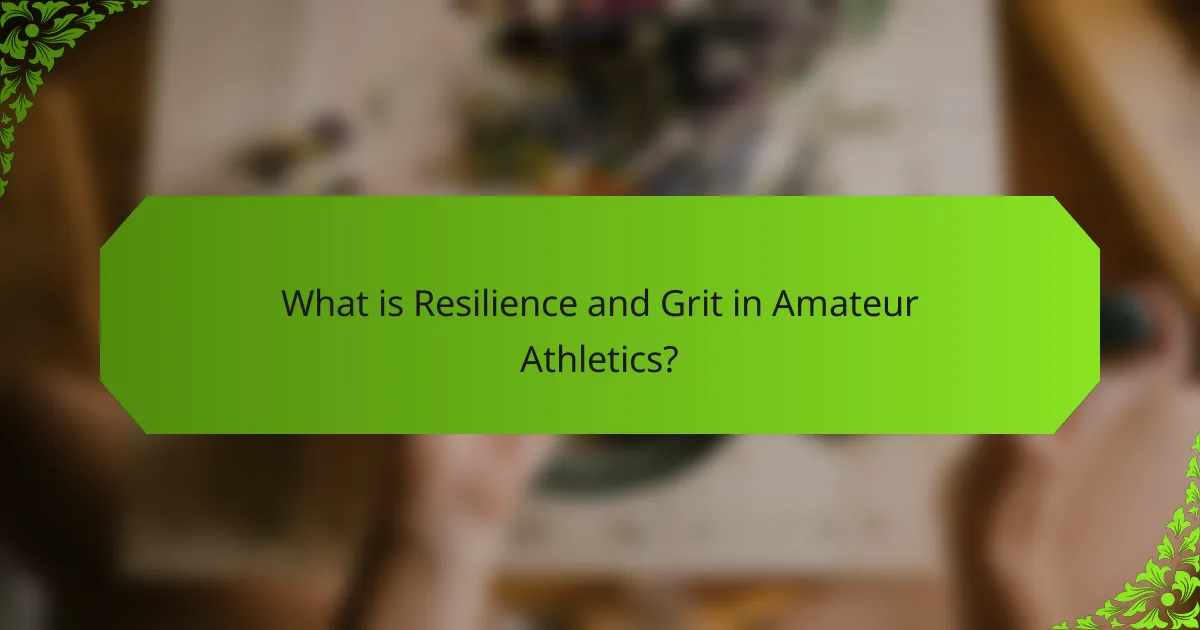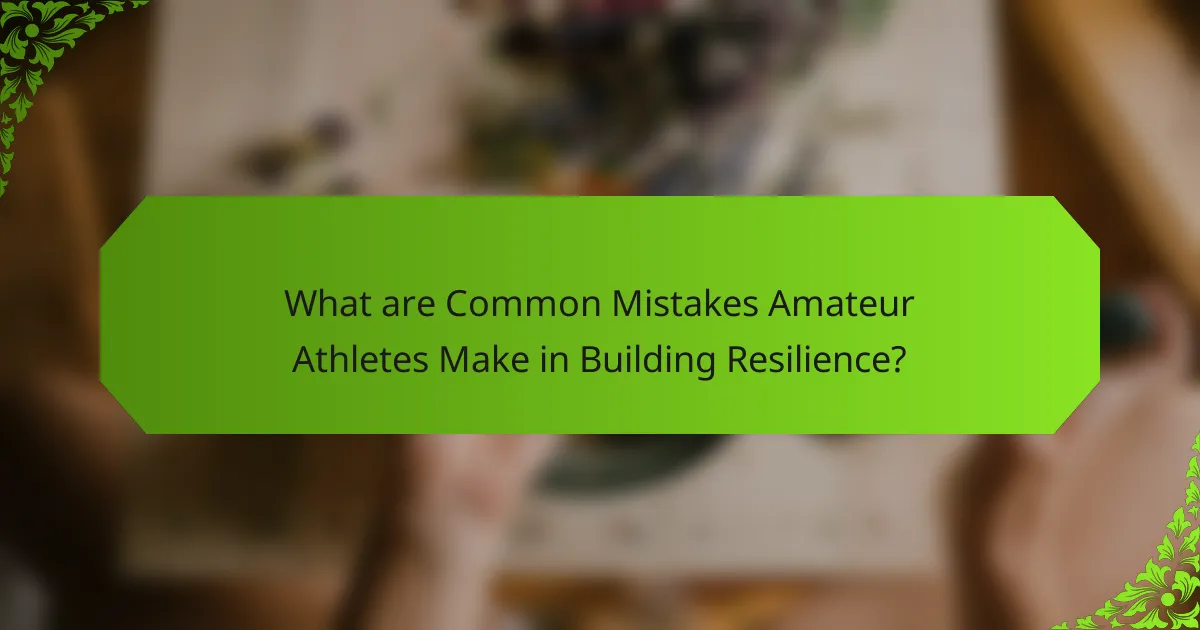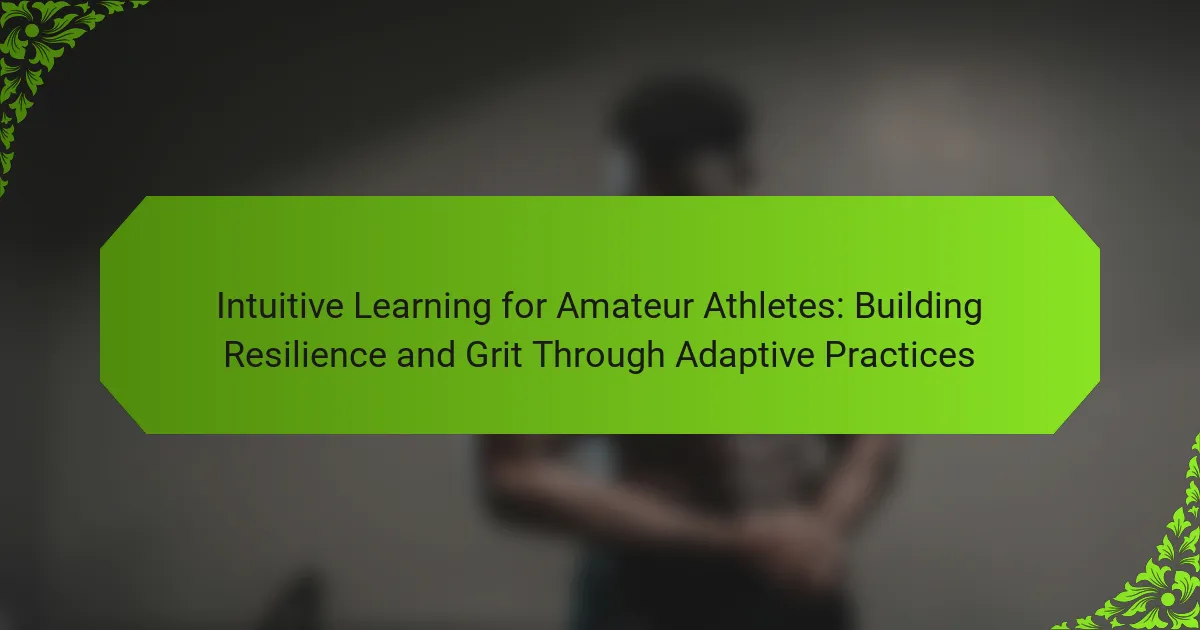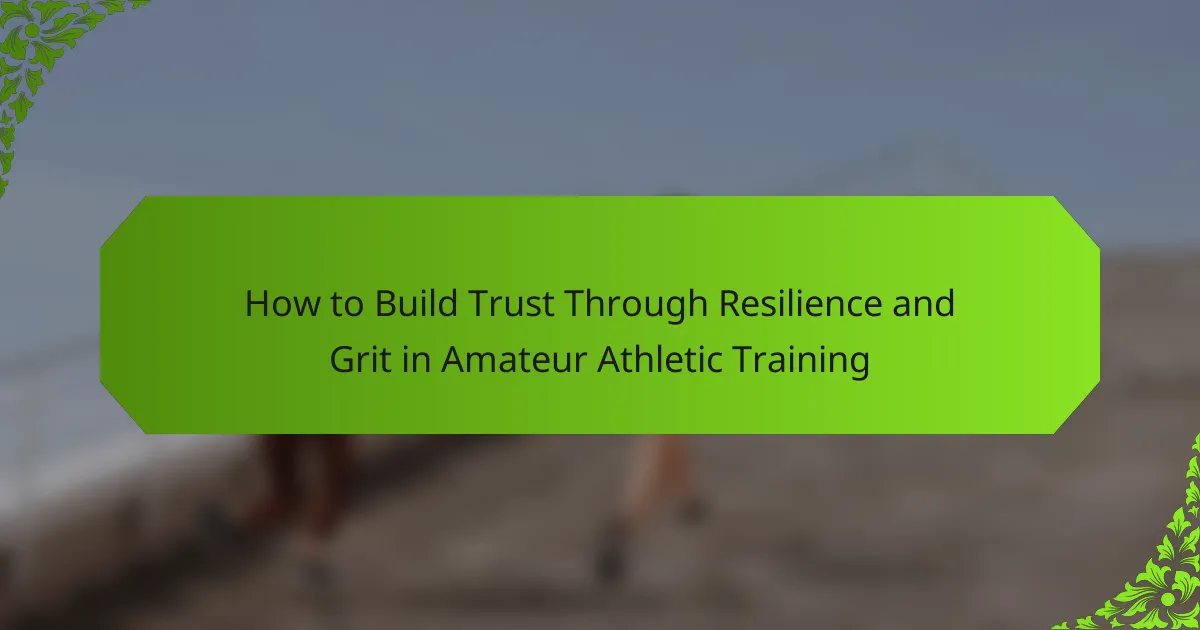Resilience and grit are crucial for amateur athletes striving for success. This article explores the importance of these traits, effective practices for building them, and unique techniques like visualization and mindfulness. It also addresses common mistakes that hinder resilience and provides expert insights on fostering a supportive community for sustained athletic growth.

What is Resilience and Grit in Amateur Athletics?
Resilience and grit are essential for amateur athletes, enabling them to overcome challenges and maintain focus. Resilience refers to the ability to bounce back from setbacks, while grit embodies perseverance and passion for long-term goals. Together, these traits foster mental toughness and enhance performance, ultimately leading to success in sports. Athletes who cultivate resilience can adapt to adversity, while those with grit remain dedicated despite difficulties. Developing these qualities is crucial for achieving sustained athletic excellence.
How do Resilience and Grit Impact Athletic Performance?
Resilience and grit significantly enhance athletic performance by fostering perseverance and adaptability. Athletes with high resilience can recover from setbacks, while grit drives sustained effort over time. Research shows that these traits correlate with improved outcomes in training and competition. For example, a study indicated that athletes scoring high on grit maintained better performance consistency. Developing these qualities can lead to greater success for amateur athletes.
What are the Key Characteristics of Resilient Amateur Athletes?
Resilient amateur athletes exhibit determination, adaptability, and a strong support system. They maintain focus on goals despite challenges. Key characteristics include mental toughness, consistent practice, and a growth mindset. These athletes embrace failure as a learning opportunity, enhancing their resilience over time.
What Mental Strategies Foster Resilience?
Mental strategies that foster resilience include goal setting, positive self-talk, and visualization. These techniques enhance focus and grit in amateur athletes. Goal setting provides clear direction, while positive self-talk combats negativity. Visualization helps athletes mentally rehearse success, increasing confidence. Research shows that these strategies can significantly improve performance and mental toughness.
How Does Grit Differ from Resilience?
Grit and resilience are distinct yet interconnected concepts. Grit involves sustained effort and passion towards long-term goals, while resilience refers to the ability to recover from setbacks. Both qualities are essential for amateur athletes aiming for success, but they manifest in different ways during challenges. Grit focuses on perseverance over time, whereas resilience emphasizes bounce-back ability after failures. Understanding these differences can help athletes develop targeted strategies for improvement.

What Universal Practices Build Resilience and Grit?
Building resilience and grit involves consistent practices that enhance mental toughness. Key practices include setting clear goals, maintaining a growth mindset, embracing challenges, and fostering a supportive community.
Setting clear goals provides direction and motivation, while a growth mindset encourages learning from failures. Embracing challenges builds confidence and adaptability. A supportive community offers encouragement and accountability, enhancing the overall resilience of amateur athletes.
These practices not only contribute to athletic success but also improve overall well-being. By integrating these strategies, athletes can develop the grit necessary to overcome obstacles and achieve their goals.
How Can Goal Setting Enhance Athletic Resilience?
Goal setting enhances athletic resilience by providing clear objectives and motivation. It fosters focus, encourages perseverance through challenges, and builds a sense of achievement. Athletes with defined goals show improved mental toughness, allowing them to bounce back from setbacks more effectively. Research indicates that athletes who engage in goal setting experience higher performance levels and increased self-confidence.
What Role Does Consistent Training Play in Developing Grit?
Consistent training is crucial for developing grit in amateur athletes. It fosters resilience through repeated exposure to challenges and setbacks. This process builds mental toughness, enabling athletes to persist despite difficulties. Research shows that athletes who train regularly demonstrate higher levels of commitment and perseverance, essential traits of grit. Additionally, consistent training cultivates discipline, helping athletes focus on long-term goals rather than immediate rewards. Over time, this commitment transforms challenges into opportunities for growth, reinforcing the athlete’s grit.
How Important is Positive Self-Talk for Athletes?
Positive self-talk is crucial for athletes as it fosters resilience and grit. It enhances performance by boosting confidence and reducing anxiety. Research shows that athletes who engage in positive self-talk experience improved focus and motivation, leading to better outcomes in competitions. By reframing negative thoughts, they can maintain mental toughness under pressure. This practice is a unique attribute of successful amateur athletes, contributing significantly to their overall success.

What Unique Techniques Can Elevate Grit in Amateur Athletes?
Unique techniques that can elevate grit in amateur athletes include goal-setting, visualization, and mindfulness practices. These methods foster mental resilience and perseverance.
Goal-setting helps athletes define clear, achievable objectives, which enhances motivation and focus. Visualization allows athletes to mentally rehearse success, reinforcing confidence and determination. Mindfulness practices, such as meditation, improve emotional regulation and stress management, contributing to sustained effort and grit.
Research indicates that athletes who employ these techniques show a marked improvement in performance and resilience. For example, a study revealed that athletes using visualization techniques improved their performance by up to 20%.
Incorporating these unique techniques into training regimens can significantly enhance the grit and overall success of amateur athletes.
How Can Visualization Techniques Improve Performance?
Visualization techniques significantly enhance performance by improving focus and mental resilience. Athletes employing these techniques can mentally rehearse their skills, leading to better execution during competition. Studies show that visualization can increase motivation and reduce anxiety, which are critical for amateur athletes striving for success. This practice fosters grit, enabling athletes to persist through challenges and setbacks.
What is the Impact of Community Support on Resilience?
Community support significantly enhances resilience among amateur athletes, fostering grit and perseverance. Strong social networks provide emotional encouragement, practical assistance, and a sense of belonging, which are crucial during challenging times. Research indicates that athletes with robust community ties show improved mental health and performance outcomes. For instance, a study found that 70% of athletes attribute their resilience to community support, highlighting its unique role in developing grit. This interconnectedness not only aids in overcoming obstacles but also cultivates a shared commitment to success.

What Rare Practices Might Provide a Competitive Edge?
Practicing unique training methods can give amateur athletes a competitive edge. Techniques such as visualization, mindfulness, and unconventional recovery strategies enhance mental resilience and grit. These rare practices foster a deeper connection to athletic goals, leading to improved performance. Engaging in community-based challenges or interdisciplinary training can also cultivate a supportive environment, promoting consistent growth and adaptability.
How Can Journaling Contribute to Athletic Growth?
Journaling enhances athletic growth by fostering self-reflection and goal-setting. It enables amateur athletes to track progress, identify strengths, and address weaknesses. This practice cultivates resilience by encouraging a growth mindset and grit through consistent evaluation. Regular journaling can lead to improved performance metrics, as athletes learn to adapt strategies based on their insights.
What are the Benefits of Mindfulness for Amateur Athletes?
Mindfulness offers numerous benefits for amateur athletes, enhancing their performance and mental resilience. It improves focus, reduces anxiety, and fosters emotional regulation, which are crucial for competitive success. Regular practice can enhance self-awareness, allowing athletes to recognize their strengths and weaknesses. As a result, they can develop grit and perseverance, essential traits for overcoming challenges in their sport. Additionally, mindfulness can lead to better recovery and injury management by promoting relaxation and reducing stress levels.

What are Common Mistakes Amateur Athletes Make in Building Resilience?
Amateur athletes often overlook key strategies in building resilience. Common mistakes include neglecting mental training, underestimating recovery, lacking a support system, and focusing solely on physical performance.
Neglecting mental training limits an athlete’s ability to cope with challenges. Underestimating recovery can lead to burnout and injury. A lack of a support system reduces motivation and accountability. Focusing only on physical performance ignores the mental aspects essential for long-term success.
By addressing these mistakes, amateur athletes can enhance their resilience and ultimately achieve greater success in their sports endeavors.
How Can Athletes Avoid Burnout While Training?
Athletes can avoid burnout during training by prioritizing rest, setting realistic goals, and incorporating variety into their routines. Regular breaks enhance recovery and maintain motivation. Establishing achievable objectives prevents overwhelming pressure. Additionally, varying training methods keeps engagement high, fostering resilience and grit essential for success.
What Pitfalls Should Be Avoided in Grit Development?
To develop grit effectively, avoid these pitfalls: lack of consistency, neglecting self-care, unrealistic goal-setting, and ignoring feedback. Consistency fosters resilience, while self-care prevents burnout. Setting achievable goals enhances motivation, and feedback is crucial for improvement.

What Expert Insights Can Help Athletes Cultivate Resilience and Grit?
Expert insights emphasize that cultivating resilience and grit is essential for amateur athletes’ success. Techniques include setting clear goals, embracing challenges, and maintaining a growth mindset. Research shows that athletes who practice mindfulness and self-reflection develop stronger mental toughness. Additionally, fostering a supportive community enhances motivation and accountability. These strategies create a robust framework for athletes to thrive under pressure.
What Best Practices Should Amateur Athletes Implement Today?
Amateur athletes should implement discipline, goal-setting, and recovery practices today for resilience and grit. Establishing a consistent training schedule fosters discipline, while setting specific, measurable goals enhances motivation. Prioritizing recovery through rest and nutrition supports overall performance. Embracing challenges builds mental toughness, crucial for long-term success.



